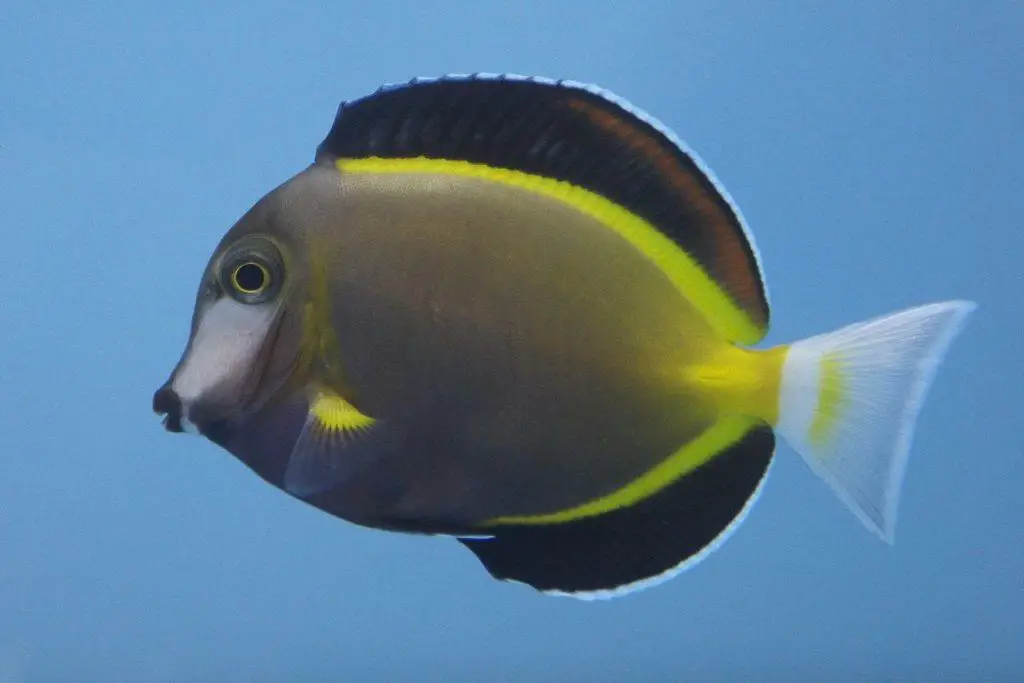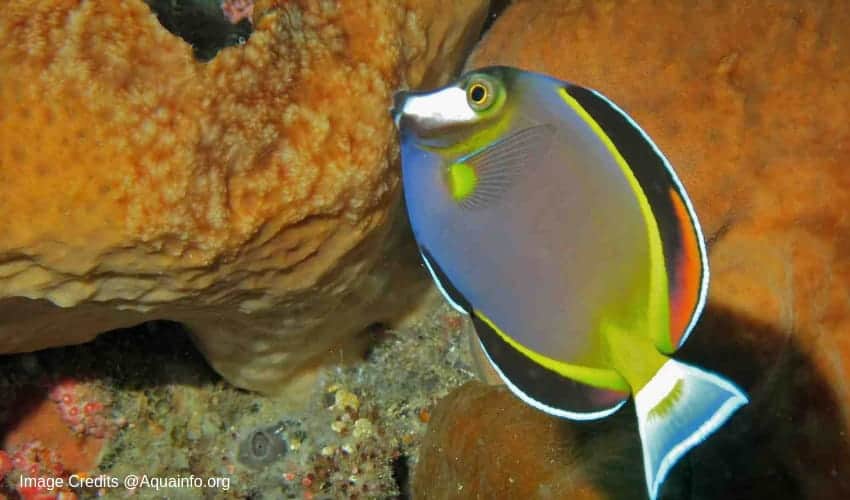Keeping a fish tank at your home or office is known to have many benefits. Apart from adding an X-factor to the interior design and improving the overall look, it has numerous health and spiritual benefits. An aquarium helps in lowering blood pressure, stress, and anxiety. Water has a deep association with human beings. It brings mental peace and serenity. That explains why we love the rains, sea beaches, and waterfalls so dearly. In addition, many cultures believe that keeping a fish tank boosts income and luck.
Many years ago now, we decided to buy a saltwater fish tank for our living area. However, the big question was which fish to choose. We surfed through numerous online reviews and took a consultation from friends and the local aquarium store. After a good thought, we zeroed-in on the Powder Brown Tang or (Acanthurus japonicus) if you like to use their Latin name. It was a great choice I guess because it is still alive and swimming!
Table of Contents
Quick Topic Links
- History and origin
- Physical Features
- Buying Tips
- Tank Size
- Breeding
- Feeding Habits
- Water Conditions
- Aquarium Care
- Compatibility
- Reef Compatibility
- Final Thoughts
If you already own or are planning to buy a Powder Brown Tang, here a list of guidelines to take care of them:
History and origin of the Powder Brown Tang
Understanding the species and their origin is one of the first steps to effectively take care of your Powder Brown Tang. They are also referred to as Powder Brown Surgeonfish, Japan Surgeonfish, Powder Black Surgeon, White-Nose Surgeonfish, and even White-Faced Surgeonfish in some parts of the world. They are said to originate from the Philippines and the Indian Ocean.
Today it can be found naturally in Japan, Taiwan, Indonesia and of course the Philippines. They are a wild fish species of fish. They are most vulnerable to Saltwater fish disease which can be treated by dipping the fish in a pH-modified water container for a couple of minutes.
Powder Brown Tang Physical Features
The Powder Brown Tang as its name suggests in mostly brown in color with a white mark just under the eyes. The fins are of a darker shade of brown than the body with thick blue outlines around them.
The tail is a gradient of blue and brown – blue being the predominant color. From the origin of the tail, yellow curved lines flow along the body. A fully grown Powder Brown Tang is between 8 to 8.3 inches in length. The tail of the fish is usually sharp and you have to take care not to injure your hand while handling them.
| Scientific Name | Acanthurus japonicus |
|---|---|
| Common Names | Powder Brown Surgeonfish, Japan Surgeonfish,White-faced Surgeonfish |
| Family | Acanthuridae |
| Origin | Philippines |
| Size | Max 8-8.5" |
| Diet | Herbivore |
| Temperament | Semi-aggressive |
| Care Level | Moderate |
| Color | Red, Tan, Yellow |
| Tank Size | 125+ Gallons Recommended |
| Water Conditions | 73-78° F, dKH 8-12, pH 8.1-8.5, sg 1.021-1.026 |
| Cost | $40 Juvenile $200 Adults |
Buying Tips
Powder Brown Tangs are usually caught from the wild and are susceptible to parasite attacks and other diseases. Some of the fish also die when they are transferred from their original habitat to fish tanks. It is, therefore, a good idea to resist buying the tiny and cute ones and choose the ones which have at least lived in the tank for some months.

These fishes have accustomed themselves to the new habitat, whereas the little ones might still be vulnerable and could die unable to adjust to the changes. You would not want your fish to die. Would you? One of the easiest ways to figure out whether the fish is healthy or not is by trying to feed it whilst it’s still in the store. If it is active and eats the food; it is most probably in a healthy condition. However, if it shows any aversion to food, it could mean health issues such as ammonia burns.
We have a complete guide to most fish diseases on our website and I’ll include a link here. It will give you some great tips on what to watch out for when buying a new species.
Tank Size
Powder Brown Tangs are free-flowing and an active fish species. Even a solo tang needs at least 100 gallons of water to survive longer and grow to its full length. We have kept our fish in a 120-gallon tank but later upgraded to an even bigger one as all the fish grew. We have now transferred them to a 200 gallon aquarium.
Larger space will ensure a longer life for the fish and at the same time allow for better mobility within the water. As they originate from places where they are used to larger spaces, smaller compact spaces might make it feel sick and hamper its overall health and lifespan.
Breeding Powder Brown Tangs
Powder Brown Tangs are a headache to breed. They scatter their eggs openly in the water which makes it very difficult to manage and oversee the breeding process. The eggs fertilize, the very moment it comes out of the mother fish and floats on the water surface.
Taking care of the Powder Brown-Tang in its larvae stage can be challenging and almost impossible at times. It can be very costly and impractical to create a model breeding-ground for the fish. This is the reason that over 90% of the Powder Brown Tang you will see is captured from their original wild natural locations.
Most home aquariums are not big enough to house a number of Tangs without them fighting so finding a mating pair it almost impossible. Hence, most species are wild-caught.
Feeding Habits of the Powder Brown Tang
Taking care of the food that is served to the fish is the most important task to do without fail. Other pets like dogs can attract your attention when they are hungry. However, the fish can give you no physical indications of hunger and might eventually die.
I feed my Powder Brown-Tang three times daily apart from the coral reefs in the water tank. It is also essential to put food at set intervals and not give away all the food at one time. Powder Brown Tang are herbivorous and will feed on any green leafy vegetables like broccoli and spinach. They also love to have a treat of marine algae.
We feed ours on Two Little Fishies-Sea Veg-Green Seaweed which we order from Amazon because it’s cheap and fast delivery. Super nutritious, Natural Green Seaweed sheets. Which are ideal for marine herbivores such as Tangs and Surgeonfish, Moorish Idols, Parrotfish, Angelfish, large Butterflyfish and herbivorous freshwater fishes, such as Cichlids and Goldfish.
We also use seaweed strips which we hold in place with saltwater safe plastic food clips.
Water Conditions
While the tangs need to be moderately maintained, it is essential to provide a stable environment to assist in the proper growth and health condition of your aquatic pet. Since, the time we brought the Powder Brown Tang into our family, care is taken to maintain similar temperature conditions.
The temperature of the water can vary naturally according to the season and climatic conditions. Cold winters and hot summers can make the water cooler or warmer. We take care to maintain the temperature in and around 77 F. While this need not be completely precise, we have tried to maintain a tolerance of 5% from this temperature. The pH of the water should range in between 8.1 to 8.4 and salinity of 1.020-1.025 and I only use RO-DI water when I do 25% water changes every 3 weeks.

Aquarium Care
Powder Brown-Tangs are voracious eaters! They need a larger tank as a larger tank will take longer to become dirty. In addition to installing a good quality filter, you should also change 25% of the water every 2-3 weeks. Food leftovers, as well as coral particles and fish excreta, can mix up and make the water unusable pretty quickly. To exactly determine the water changing frequency, we conducted an easy test.
From the test, we changed the water in the fish tank every 3 weeks doing on average 25% each time. We also, avoided putting more food than the fish needs as these food articles can mix up easily with water and make it look messy and untidy. Be aware of over cleaning the fish tank as it may take away the helpful bacteria and leave the fish vulnerable to common diseases. Protecting the good bacteria is vital for not just the fish but also the overall ecosystem of the aquarium.
My aquarium has a refugium underneath which also breeds copepods which form a natural and essential food source throughout the day. I use a large external canister filter which, to be honest, I hardly ever clean as the refugium does a great job. If you’d like information on external canister filters then visit our complete large filter review. I have provided a link here.
Compatibility with other fish
Tangs need a lot of space and privacy. While they are otherwise temperamentally cool, you can easily irk them by keeping two of them in a relatively smaller area. As you already know, tangs will need a bare minimum of 100+ gallons of space to remain active and happy.
It is not a good idea to introduce another fish into the same tank that the powder brown tank lived before as it may lead to flared ego. However, it is possible to keep multiple tangs in the same tank. Just ensure that each of them gets enough space and are not disturbed by other accompanying fish. Ensure plenty of rocks and hiding places for when fights erupt have caves for them to escape and feel safe. The keyword here is to get a large tank. Also, be careful introducing other species of tangs as they are usually more active and can disturb your Powder Brown Tang.
No two experiences are the same and it’s hard to say 100% which fish will get on with others. I have seen really large aquariums with several species of Tangs without issues and then I have seen smaller aquariums where I have one dominant Powder Brown who doesn’t like any other species of Tang which I found out to my horror when I tried to introduce a Powder Blue Tang. Let’s just say it didn’t end well!
Reef Compatibility
Powder Brown Tangs are extremely reef-friendly species. They will graze on the algae of the reef and will keep themselves busy and active. Several owners also claim that a reef within the tank of the fish increases its lifespan. I have talked to a few experts who believe the same thing. So, we put a reef within the tank. Though with constant grazing, some damage can also be seen on the coral and the worms, it is relatively safe (in fact advisable) to keep a reef in the fish tank. One of the ways to prevent constant nibbling is to feed it well and on time. A well-fed Powder Brown Tang is less likely to aggressively graze and damage the reef.
Final Thoughts
If you follow this Powder Brown Tang care guide, your fish can easily last up to 7 years. Powder Brown Tangs are beautiful and active fishes which you can watch for hours without getting bored. The beautiful and contrasting colors of the fish are a visual treat. I get rid of all my stress and tiredness as I enter my home and look at the pair of fishes swimming and playing with glee.
Let me tell you though that you have to take proper care of this species if you decide to keep them as your pet. If you are single and stay away from home regularly, then Powder brown tang is definitely not for you my friend. It requires your care and attention. They need excellent water conditions and a variety of food sources to ensure they thrive.
From my personal experience, keeping Powder Brown Tangs is a little more challenging than some other species. However, I take proper care of the fishes and they have almost attained full size now. I hope this Powder Brown Tang care guide gives you a good insight as to how you can take care of your tang properly. If you are planning to buy one, well what are you waiting for?
- Comparing Aquarium Gravel To Sand – Which Is Best For Your Tank?
- Silver Arowana: Complete, Care, Breeding, Feeding Guide
- Rainbow Shark: Diet | Size | Breeding | Cost
- Tiger Barb Fish: Diet | Breeding | Size | Water Conditions
- Jack Dempsey: Diet | Size | Breeding | Lifespan | Sexing | Care Guide

I have been working in the tropical fish industry for over 30 years now and I’m still learning. Everyday is a school day in this hobby. In my spare time I play golf very badly!



